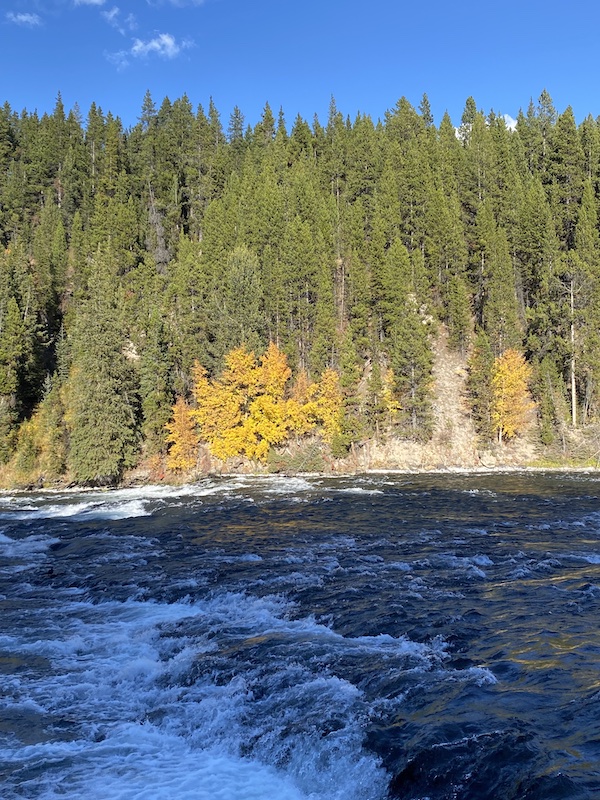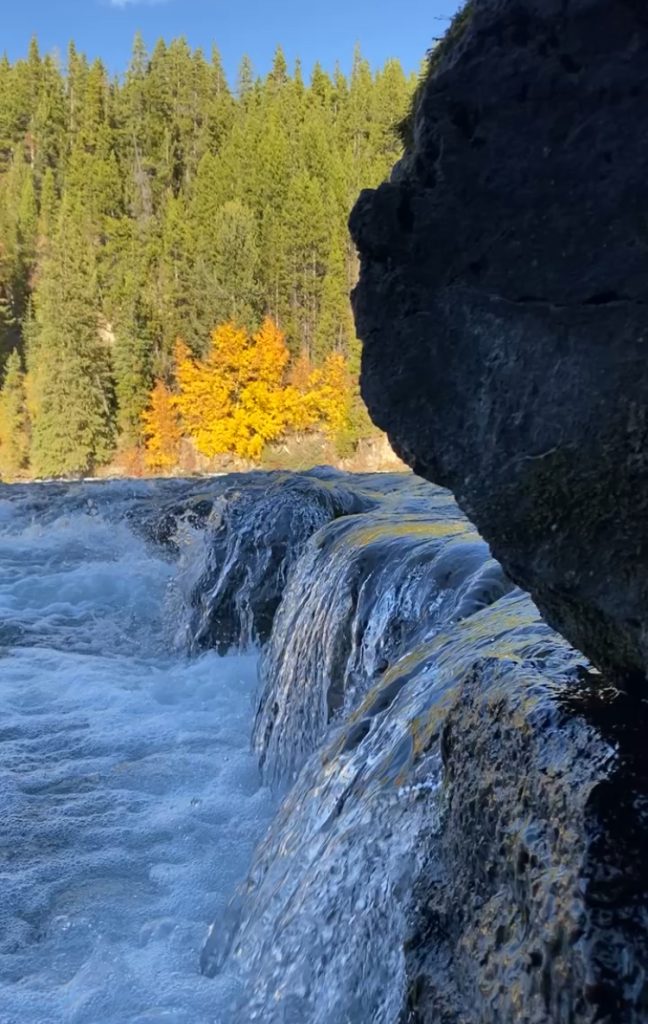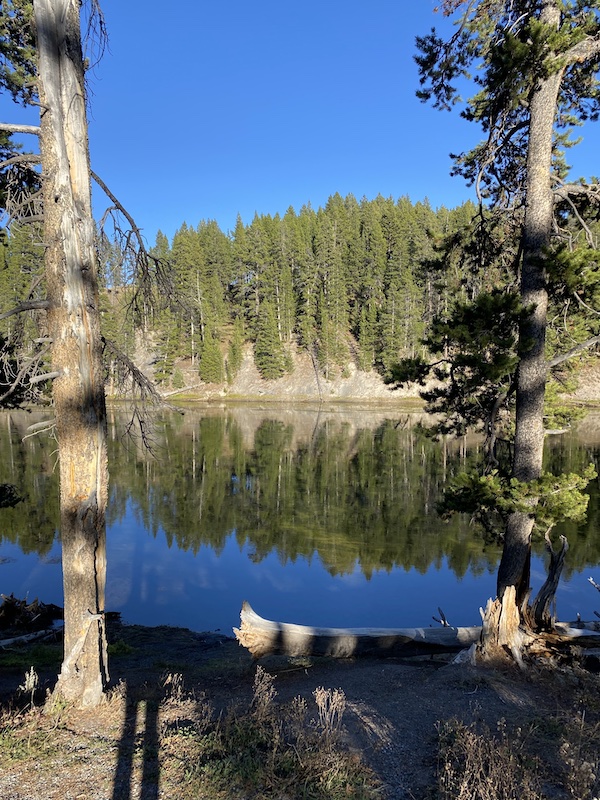
Walking under a canopy of lodgepole pines, I heard the melody of the rapids long before we reached the river. Although the day was sunny and dry, the season had been wet, and the ferns flourished in the shade bestowed by the towering trees lining the bank. Here at LeHardy Rapids, the Yellowstone River is tranquil and wide—showing a different face than it presents as it plunges over the Upper and Lower Falls on its race through the park’s Grand Canyon. We strolled along the water, our footsteps silent on the damp dirt trail, taking in the scent of pine and the sound of music. When we came to a tall railing, we stopped to watch the sun shimmering on the surface.

Water stops are always long for our family and I am always ready to move on long before my husband. So I did. I wandered down the trail, leaving him to watch for trout as the river unwound itself again and again on its journey toward the canyon and the far edge of the park. Making my way down the path, I passed through sunbeams breaking softly through the sheltering pines, casting their illuminating glow on the moss thriving on the branches.
It all looked so healthy and whole. It wasn’t until I turned to go back to my husband, still standing at the railing, that I noticed a sign:
TRAIL CLOSED
FOR RESTORATION
Situated on the ground, it wasn’t easily seen.
A Closer Look
Here’s what was interesting: The trail itself looked fine. It was the area around it that was in rough shape. The foliage was shorter and some places were bare, worn by the feet of those who left the official trail to walk down to the water. From a distance, this place, too, looked healthy and whole. Only with a close look could you see that the edges were frayed.
Maybe you know what that’s like. I know I do.
About Jesus’ words regarding the birds of the air and the lilies of the field, Matthew Henry wrote this: “There is a great deal to be learned from what we see every day, if we would but consider it.” While actual wilderness places may not be part of our every day, they are filled with the makings of what we do see every day—water, trees, sun, earth, and signs among them. We can learn a little more of what it means to navigate the ups and downs of actual, everyday life by faith from this little sign along the path at LeHardy Rapids. We have only to “consider it.”

Transitions
May is the reputed Mother of All Transitions. With the gathering up of all that May lets loose, September runs pretty closely at her heels. Every single year.
I don’t know about you but I am not always a fan of change and transition is change by another name. And the longer I live, the more obvious it is that life is one long series of transitions. We’re always making our way from one thing or age or stage to the next.
If knowledge is power then understanding this reality gives us something we need: perspective to walk through transitions wisely and well, by faith not by fear or by autopilot. It’s important to pay attention to these transitions. The little ones. The big ones. The ones in-between.
Whether you’re facing a massive transition or something more moderate, take a moment to look around. Ponder your figurative path. Check your trajectory. Assess the borders and boundaries to see if they need some shoring up, some attention, or maybe—like the trail at LeHardy Rapids—some rest.
🧭 Look around: What is the most healthy and whole way to navigate the landscape of your life as it is right now?
take heart & happy trails ~ Natalie
p.s. Big news! My book, Waking Up in the Wilderness: A Yellowstone Journey will be available on October 21 and I couldn’t be more excited! You can learn more here and keep up with book news here.
I’m linking this tale from the trail at #tellhisstory, InstaEncouragements, Let’s Have Coffee, and Grace & Truth.
Your pictures sparkle with beauty, your words brim with hope. Thank you, Natalie …
Thanks for those encouraging words, Linda!
Love this, Natalie—especially, “Ponder your figurative path. Check your trajectory. Assess the borders and boundaries to see if they need some shoring up, some attention, or maybe—like the trail at LeHardy Rapids—some rest.” This is such advice in so many ways. Congratulations on your book!
Thanks, Ashley! I’m always needing to remind myself of those words you reiterated.
We came across closed trails this summer due to nearby mama eagles nesting on their eggs. The national park did not want the wildlife disturbed as the eagles tended their unborn. It makes me think that closed trails are for rest, and also to birth something new, undisturbed and undistracted. Congrats on your book!
Rest for sure, but I love your observation about birthing something new with out distraction or disturbance. And thanks, Lynn!
Observation and perspective make a considerable difference, Natalie. I’m rejoicing with you on your new book. Congratulations!
Perspective (and the observation that accompanies it) have tremendous power to change our thinking and bring it into alignment with God’s. And thank you! It’s an exciting time.
Natalie, thanks for this needed reminder to make our way through this month’s many transitions with Jesus as our ever-present Guide and Hope.
Reminding one another of the truth is one of life’s great blessing–mostly because I’m grateful for the people who have reminded me!
Change seems to be on the agenda whether we like it or not. I know for sure that I wouldn’t want to navigate change without the help of a God who “changes not!”
Agreed. I’ve been surprised at the rate of change as I’ve moved through middle age. And without the steadfastness of a God who doesn’t change, I’d be lost.
Natalie, I am not a fan of change but change (transitions) are unavoidable. It is important to pay attention for we can miss all the Lord has for us in the moment. And somehow, as we pay attention, or consider all that is around us, the Lord gently prepares us for what is up ahead.
As always, your photos are as beautiful as your thoughts. Thank you for sharing them!
Our attention can make all the difference, can’t it? And God’s so good in all of it. Thanks for you kind words. They are much appreciated.
How exciting about your book!
I like some changes. Others, not so much. One year when we had a lot of changes (moving out of state, two older sons leaving home, new school for the youngest, etc.), a line from the hymn Be Still My Soul was my mainstay: “In every change, He faithful will remain.”
Thanks so much, Barbara! Your list of changes was a lot for one year–and what a good choice of truthful words to hold on to. You’re a wise woman!